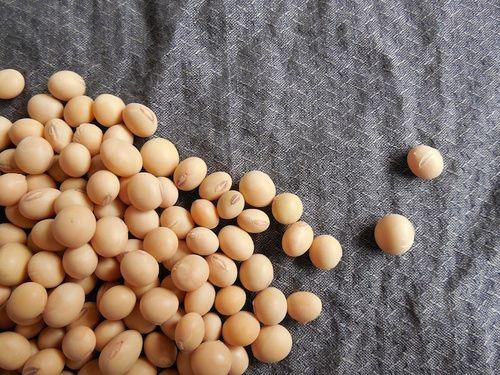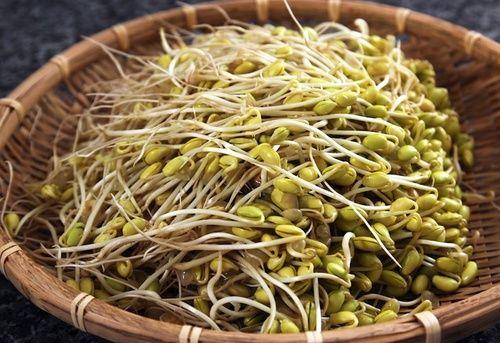Soybeans they are legumes rich in proteins and lecithin. Fromprotective action for the arteries, they are also useful against cholesterol. Let's find out better.
> 1. Description of the soy beans
> 2. Properties and benefits of soybeans
> 3. Calories and nutritional values of soybeans
> 4. Allies of
> 5. Curiosities about soybeans
> 6. A recipe up your sleeve

Description of soybeans
Glycine max or yellow soy is a herbaceous plant native to the Far East (Japan, China, Indonesia) where it is used as the basis of the current and former traditional diet. In today's world it has been introduced to Europe and America in its innumerable and varied forms of preparation and transformation.
With the name "soy beans”Commonly we mean different types of beans although to be more correct we should speak of yellow soybeans. In fact, we find under the same name the green soybeans, that is the green azuki (vigna radiata) and the red soy, Or the red azuki (phaseolus angularis) which have properties and chemical composition different from yellow soybeans.
Yellow soybeans are the most widely grown in the world because their nutrient composition and texture make them very versatile for transformations and commercial preparations of all kinds.
The resulting products are: vegetable milks, pudding-like desserts, creams, yogurt, ice creams, tofu (soy "cheese"), tempeh (semi-fermented), meat-like "steaks", frankfurters, meatballs, various sauces fermented (tamari, shoyo, miso) and many other preparations.
In addition, a oil light, rich in polyunsaturated fatty acids and used to control cholesterol. The use of soybeans is indicated not only for human consumption, but also as feed for farmed animals thanks to the high percentage of proteins contained.
Properties and benefits of soybeans
Soybeans are very rich in proteins (35%) and the composition of fats is also good (18% including omega3); for this reason they are promoted as meat substitute food in vegetarian and vegan diets.
The consumption of soy must not exceed because, being a legume, it contains cysteine and thionine (the two essential amino acids) in low percentages, so the advice is always to combine legumes and cereals, which are naturally rich in these two amino acids.
Soybeans contain good percentages of vitamin E and B9, minerals such as iron and potassium and finally a lot of fiber. There soy lecithin has a protective effect on the arteries, preventing the precipitation of cholesterol and thus ensuring protection from cardiovascular diseases (useful in cholesterol control diets).
Soybeans also help regulate weight because they produce a high sense of satiety during the meal and therefore make the portion doses resize. Due to its composition it is a food suitable for celiac sufferers seen theabsence of gluten.
Soybeans also contain special substances such as i phytoestrogens, specifically daizeine and genistein isoflavones, capable of regulating and rebalance hormones; for example, in premenstrual syndrome they are useful for lowering estrogen or on the contrary to increase them at the time of menopause, in which the dose of estrogen increases thanks to the use of soy in the diet.
The use of soybeans is recommended for the prevention of prostate cancer in men and women breasts and uterine fibroids in women, so much so that in eastern countries, where the use of soy is conspicuous, they are those with the lowest tumor incidence in the world.
Calories and Nutrition Facts of Soy Beans
100 g of cooked soy beans (without added fat) contain 172 kcal / 720 kJ.
Furthermore, for every 100 g of this product, we have:
- 16,54 g protein
- G carbohydrates 9,87
- Sugars 2,98 g
- 8,92 g fat
- Cholesterol 0 mg
- Fiber 6 g
- Sodium 232 mg
- Potassium 512 mg
Soy beans, ally of:
Heart, vessels, intestines.
Learn about the properties, uses and benefits of bean sprouts

Curiosities about soybeans
Soybeans are among the seeds most at risk of GMOs and it is therefore generally recommended to purchase in shops that sell food grown from organic farming which guarantees the absence of GMOs in its ingredients.
In addition, some processed products obtained from yellow soybeans such as "yeast extracts", Used to flavor sauces, gravies and various dishes, are obtained from the hydrolyzation process that releases the glutamate, substance suspected of causing disturbances of the nervous and visual systems.
A recipe with soy beans
ingredients:
- 250 gr yellow soy beans,
- 1 onion or leek,
- 2 courgettes,
- 2 carrots,
- 500 gr tomato puree or diced fresh tomatoes,
- olive oil, salt and spices to taste.
Preparation: The yellow soy must be soaked for 4 to 6 hours in water (which will be thrown away to remove harmful substances) and then cooked in salted water to the desired consistency. At the same time prepare a sauté with onion or leek, zucchini and carrots into small pieces and then add the tomato. Sauté for 10 minutes, add salt and spice to taste, add the drained soy and continue cooking for a few more minutes, stirring well.
READ MORE
Soybeans among the foods rich in omega 3: discover the others
| Maangchi.com


























